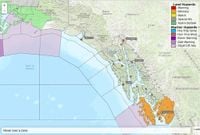As summer 2025 draws to a close, Americans are experiencing a tale of two climates—one that defies expectations and upends the usual weather script. While Texas, a state notorious for its sweltering summers and relentless heat, has enjoyed a surprisingly mild season, Alaska, famed for its cool, temperate summers, is currently sweating under a rare and unexpected heat advisory. The contrast is as stark as it is newsworthy, and it’s got residents, meteorologists, and climate watchers alike scratching their heads.
According to Mix 93-1, by August 29, 2025, Texas has managed to dodge the kind of punishing heat waves that typically blanket the state. In a striking departure from the norm, there’s only one burn ban in effect across East, North, and Deep East Texas. This is a dramatic shift from previous years, where multiple counties would already be under restrictions due to high temperatures and bone-dry conditions. Instead, unsettled weather patterns have brought rain and kept temperatures hovering around average, sparing Texas the usual 100°F-plus scorchers that define its summers.
“Because we've had a pretty unsettled weather pattern all summer long, giving us chances of rain and keeping our temperatures around normal, things aren't as dry as they normally are,” Mix 93-1 reported. This break from the norm has been a welcome relief for Texans, who have been able to enjoy more outdoor activities—more biking, more water skiing, and more time at the playgrounds with their kids. “It’s been a relatively good summer for us,” the outlet noted, with a hint of pleasant surprise.
Yet, despite the milder weather, Texas hasn’t lost its reputation as one of the hottest places in the country. AccuWeather recently ranked the ten hottest U.S. cities with populations over 250,000, and Texas claimed three spots on the list. The state’s cities are no strangers to heat—whether it’s the dry, searing temperatures of West Texas or the humid, sticky heat of the Gulf Coast. And while this year has been kinder, the specter of heat domes always looms large.
The so-called “heat dome” phenomenon is a familiar—and dreaded—feature for many Texans. When high pressure settles over a region, it acts like a lid on the atmosphere, trapping hot air and preventing it from escaping. “A heat dome happens when high pressure sits over a region and acts like a lid on the atmosphere. While warm air tries to escape, the high-pressure dome forces it back down to the earth,” Mix 93-1 explained. The result? Prolonged, unrelenting heat waves that can push temperatures well over 100°F. Fortunately, this year, that lid has stayed off—at least for now.
But as Texans sip sweet tea in the shade, cool off at the lake, or simply count their weather blessings, something unusual is happening far to the north. In a twist that few could have predicted, Alaska is sweltering under a heat advisory—a rare event that has meteorologists and residents alike doing double takes.
On August 28 and 29, 2025, parts of Alaska, including Prince of Wales Island’s Hollis and Thorne Bay, are experiencing temperatures reaching up to 80°F. The National Weather Service (NWS) Juneau office issued a heat advisory effective from Thursday through Friday at 7 p.m. local time, warning of the risk of heat-related illness in a region where such alerts are virtually unheard of. “Individuals not accustomed to these unusually hot temperatures for this region may experience heat related illnesses,” the NWS Juneau cautioned in its advisory, as reported by Newsweek.
While 80°F might seem like a pleasant day in Texas, it’s a big deal in Alaska—especially in late August. For perspective, the average high temperature in the Ketchikan area this time of year is around 63°F. The heat is particularly pronounced in areas away from the moderating influence of the sea. “The land and water temperature difference creates more of a pressure that can carry wind, so any areas around the water will feel that sea breeze a little more,” NWS general forecaster Zoe Kaplan told Newsweek. “That can keep temperatures down. It's mostly just any city away from the water and more inland from the channels that will feel those temperatures reaching 80.”
Indeed, cities like Ketchikan, nestled along the coast, are expected to see highs in the mid- to high-70s, while more inland spots could flirt with record-breaking heat. Kaplan noted there’s even a small chance the daily high temperature record of 81°F at the Ketchikan airport could fall during this period. “This is a little abnormal pattern for us this time of year,” she remarked, underscoring the unusual nature of the event.
What’s even more remarkable is that this Alaskan heat advisory is the only one in effect anywhere in the United States on August 29, 2025. While much of the country, including the Southern Plains and Northern Texas, is experiencing below-average temperatures—thanks in part to a cold front that has driven readings as much as 30 degrees below normal—Alaska is basking in near-summerlike warmth. For example, Perryton, Texas, in the state’s northern reaches, is forecasted to have a high of just 80°F on the same day as parts of Alaska hit the same mark. That’s a weather flip-flop few would have predicted at the start of the season.
Looking ahead, the NWS Climate Prediction Center is warning that above-normal temperatures could return to much of Alaska in the week following this heat event. For a state unaccustomed to prolonged warmth, the prospect of more heat is prompting both concern and curiosity. Are these temperature swings a sign of shifting climate patterns, or just another blip in the ever-unpredictable world of weather? The answer, as always, is complicated—but the current data suggest that, at least for now, Alaska’s summer isn’t quite done yet.
Meanwhile, Texans are making the most of their unexpected reprieve from the heat. As Mix 93-1 put it, “We’ve got our own ways of beating the heat until the weather finally gives us a break.” Whether it’s lounging under a live oak, heading for the water, or simply enjoying the outdoors without the oppressive heat, residents are savoring a summer that’s as rare as it is refreshing.
In a year when Alaska is as hot as Texas and Texas is as cool as Alaska, it’s clear that the weather still has a few surprises up its sleeve. For now, both states are learning to adapt—one by finding shade and sweet tea, the other by bracing for heat advisories and keeping a wary eye on the thermometer. The summer of 2025 will be remembered not just for its temperatures, but for the way it turned the nation’s weather map upside down.




